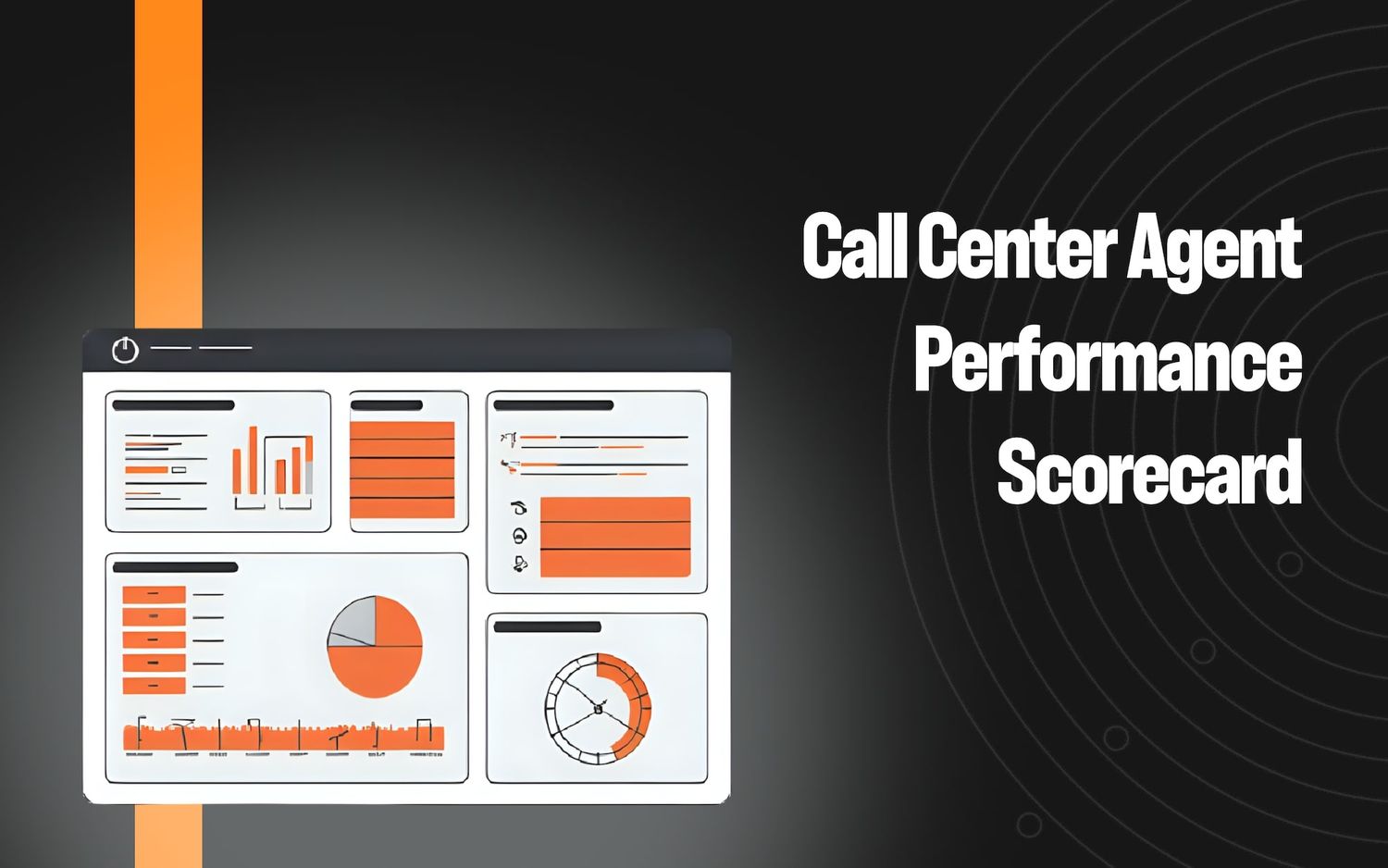9 Proven Ways to Improve QA in Your Call Center

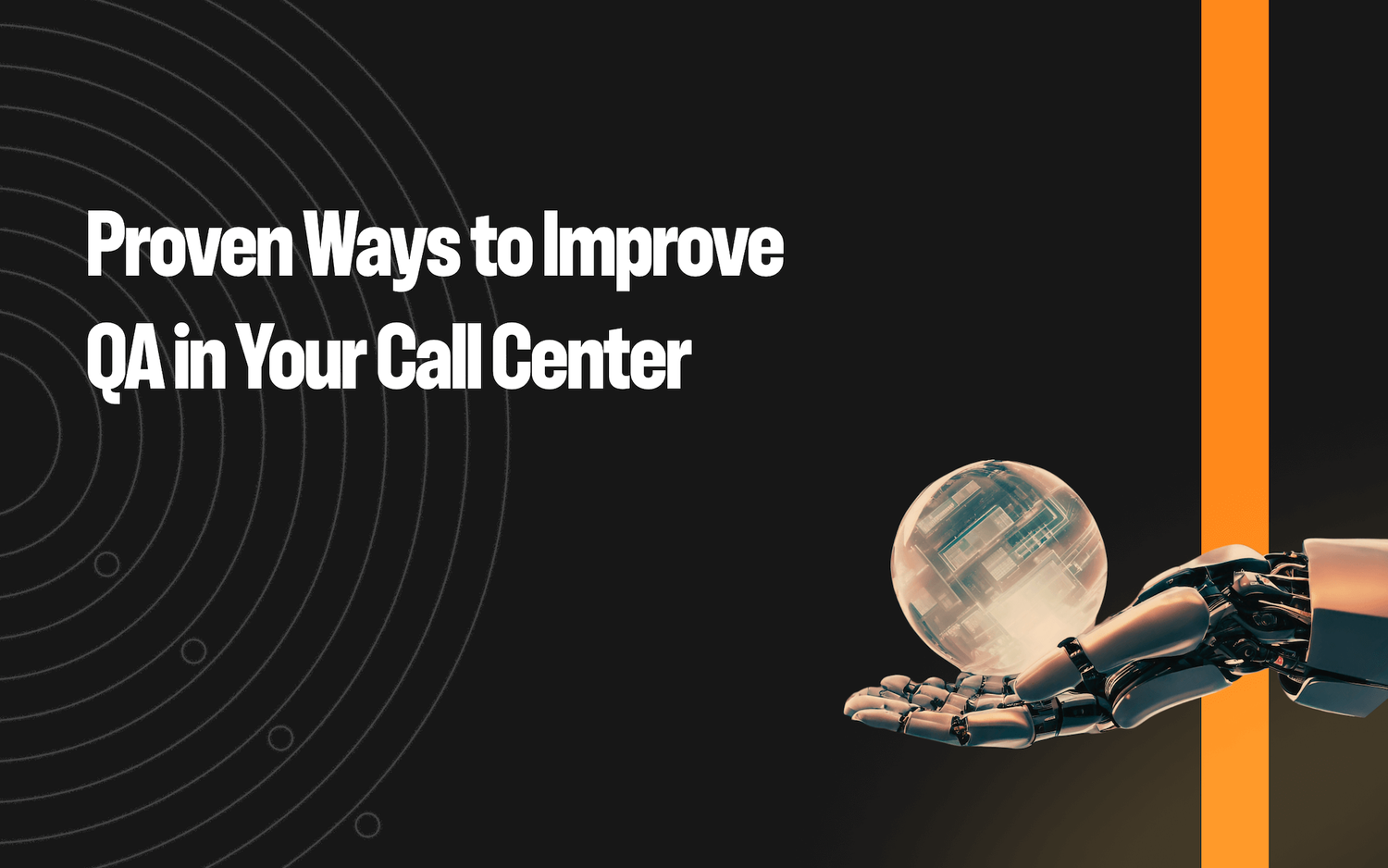
Most call centers perform basic QA by reviewing a few calls weekly, but advanced contact centers treat QA as a system-wide solution — measuring and improving every customer interaction at scale.
In this approach, QA goes beyond identifying agent mistakes — it also gauges customer sentiment and agent performance, driving continuous improvement and valuable insights across the organization.
In our experience, good QA consists of:
- Covering more, guessing less: QA should scale across all interactions, not rely on random samples.
- Spotting meaningful patterns: QA should highlight trends in customer sentiment and agent performance.
- Coaching, not catching: Focus on growth, not mistakes. Ensure feedback is fair, consistent, and constructive.
- Adapting with the business: QA should evolve as goals and customer expectations change.
Below, we distill what we learned from working with dozens of companies on call center QA into nine tips that set the best operations apart. Along the way, we’ll share real-life examples from our QA and customer experience platform, Level AI, to illustrate how leading teams apply these tips.
1. Define What Quality Means, Then Measure It
Be specific and quantitative about how you’ll define quality so it’s not just a vague motto that people only pay lip service to but can’t be measured.
Sit down with leadership and define what quality means for your organization. Is it about higher CSAT scores? Faster resolution times? Fewer call transfers? Your definition should reflect your business goals, not just industry trends.
Then, choose KPIs and benchmarks that align with those goals. Common ones include:
| First Call Resolution (FCR) | Measures the percentage of customer issues resolved during the first interaction, with no follow-up needed. A high FCR means your team is effective and efficient, and customers don’t have to keep calling back. |
|---|---|
| Average Handle Time (AHT) | The average amount of time an agent spends on a customer interaction, including talk time, hold time, and any after-call work. AHT balances speed with quality — too fast may mean rushed calls; too slow can reduce efficiency. |
| Call Quality Score | An internal score (usually from QA evaluators or software) based on criteria like tone, accuracy, professionalism, and compliance. This helps track how well agents follow your standards for a great customer experience. |
| Script Adherence | Tracks how closely agents follow approved scripts or guidelines during calls. It ensures consistency, compliance, and that critical information isn’t missed. |
| Call Transfer Rate | The percentage of calls transferred to another agent or department. High transfer rates can signal poor routing, lack of tools, or inadequate agent training to resolve issues. |
| Call Abandonment Rate | The percentage of customers who hang up before speaking with an agent. This often reflects long wait times and can hurt customer satisfaction. |
| Customer Satisfaction (CSAT) | A score based on how satisfied customers feel after an interaction, usually measured through a short post-call survey (e.g., “How satisfied were you with your experience?”). This directly measures how customers feel about the service they received. |
| Net Promoter Score (NPS) | Measures customer loyalty by asking how likely someone is to recommend your company to others on a scale of 0–10. A higher NPS suggests more loyal, happy customers — a key driver of growth. |
| Customer Effort Score (CES) | Rates how easy or difficult it was for a customer to get their issue resolved (e.g., “The company made it easy for me to handle my issue”). Lower effort = better experience. Customers who have to work hard to get help are less likely to stick around. |
But don’t stop at choosing metrics. Define exactly what “good” and “bad” look like. For example, with CES, clarify what counts as high effort (e.g., “the customer was transferred multiple times or waited on hold”) versus low effort (e.g., “the agent resolved the issue on the first call, without transfers”).
Once you’ve defined your metrics and what each means in practical terms, you can use them to inform QA scoring. This is where you evaluate individual customer interactions, not just on whether the issue was resolved, but how it was resolved.
Did the agent use the correct tone? Follow the script? Handle the issue efficiently without bouncing the customer around? Your metrics help guide what to look for and how to score it.
Then develop a scoring playbook or rubric. These break down each part of the customer interaction and assign clear criteria for what earns a high score, what doesn’t, and why. A good rubric eliminates guesswork and keeps evaluations consistent, even across different QA reviewers or teams.
For example, if one of your key metrics is Call Quality Score, your rubric might include line items like:
- Greeting and closing the call professionally
- Confirming and understanding the customer’s issue
- Demonstrating product knowledge
- Displaying empathy and active listening
- Following compliance guidelines and disclaimers
- Providing a resolution or clear next steps
Each of these can be scored on a scale (e.g., 0–2 or 0–5), with specific examples or behaviors tied to each level of performance.
This structure helps you score fairly and consistently, while aligning your training and coaching with what matters most.
When your metrics, scoring, and rubrics are all aligned, QA stops being a box to check and becomes a strategic tool for raising performance across the board.
2. Go from Monitoring a Tiny Fraction of Calls to 100% of Calls
Most call centers have historically only reviewed a subset of calls (typically 1–2% of the total) for quality purposes, since this has always been the task of humans.
This limited sample size, though representative, creates massive blind spots. Think about it: 98%–99% of customer interactions go without QA. You can end up missing key trends and sometimes even systemic issues.
Until now, this has been the status quo because only humans could reliably understand and qualitatively evaluate natural language in call recordings and transcripts — a tedious and time-consuming task.
(Our latest article on the best call center recording solutions explores how tools like Level AI’s screen recording make full QA coverage possible.)
Call centers need most of their budget for agents so the number of QA staff is always limited, which in turn limits how many customer interactions can realistically be reviewed.
Another downside of manual QA is that human evaluators invariably bring biases and inconsistencies to their judgments. An example of this is recency bias, where more weight is placed on recent interactions while overlooking patterns across a broader time frame.
But AI can understand natural language. This is transformative for call center QA because, instead of humans analyzing a small subset, computers can monitor every single customer-agent interaction around the clock. That means every call, every chat, and more.
You go from 1–2% of interactions reviewed to 100%. This changes everything, enabling massive QA possibilities you couldn't get before.
It means you can spot way more patterns and issues regarding individual agents’ performance or trends across your department that you may have missed previously.
It also means you can coach agents based on their whole body of work — not just a few cherry-picked calls. And when every interaction is reviewed, it’s easier to catch problems early, track improvements over time, and deliver a more consistent customer experience.
3. Auto-Score Agents to Free Up Time for Coaching
Scoring agent calls by hand is slow, laborious, and never-ending. QA teams often spend hours listening to random call samples, jotting down notes and filling out scorecards, just to review a small slice of what’s actually happening. The result? Most calls go unchecked, feedback is delayed, and there's barely any time left for real coaching.
Manual QA might have worked at low call volumes. But as volume grows, so does the pressure, and manual scoring quickly becomes a bottleneck. Agents get less attention. Coaching gets pushed to the side. Quality slips through the cracks.
We recommend auto-scoring agents using AI because it saves time and gives you full visibility into what’s happening across your call center.
There are several ways to use AI here, but one of the most effective methods is to auto-score agents based on how well they follow your QA rubric. If your rubric outlines specific behaviors — like greeting the customer within the first 10 seconds, confirming their issue, showing empathy, and wrapping up with clear next steps — AI can analyze recorded conversations or transcripts and check whether those boxes were ticked. It applies the same rules to every interaction, meaning scoring is consistent and fair, regardless of the agent.
(See our latest article on AI use cases in the call center.)
An example is our platform’s InstaScore, which is an overall percentage of how well an agent adhered to rubrics, and is shown next to every conversation:

InstaScore helps you zero in on conversations warranting closer scrutiny, either for good or bad reasons. For instance, you may notice an agent scoring consistently well and want to examine the call more closely to discover how the agent interacts with customers. Conversely, seeing low scores may prompt you to uncover why agents are doing poorly so you can update your coaching and training appropriately.
All in all, auto-scoring agents means less time spent listening to random calls and more time for constructive activities like coaching agents.
4. Foster a Culture of Engagement & Ownership
If you want real improvements in quality, your agents need to feel like they're part of the process instead of being judged from the sidelines. That starts with giving your QA program clear ownership. Assign a dedicated QA manager or team to oversee scoring, feedback, and overall quality strategy. This ensures accountability and gives agents a consistent point of contact for all things QA.
But don’t stop there — bring your customer support teams into the conversation. Get their feedback on what’s working, what’s confusing, and how QA can better support their day-to-day work. When agents feel heard, they’re more likely to buy in.
Transparency is a big deal. Give agents a fair way to challenge their scores. Set up a structured appeal process that clearly explains how and when evaluations can be reviewed. This helps build trust, reduces frustration, and makes scoring feel more like a conversation than a verdict.
Encourage agents to take ownership of their own goals. That means discussing clear, realistic performance targets, and backing those up with regular coaching, helpful feedback, and even career development opportunities. Let them self-monitor and support their teammates’ growth.
And don’t micromanage. Allow agents to make decisions within defined guidelines, like handling certain types of customer issues without needing supervisor approval. That kind of freedom builds confidence and strengthens accountability.
Finally, make your culture one where people can speak up. Agents should feel safe bringing up concerns, asking for help, or suggesting improvements without fear of being punished or ignored. When engagement and ownership are part of the culture, quality doesn’t just improve — it becomes a shared mission.
5. Go Beyond Surveys: Surface Customer Pain Points at Scale
Most call centers rely on post-call surveys to understand how customers feel. They send out questionnaires asking for ratings on satisfaction (CSAT), loyalty (NPS), or effort (CES). It’s been the go-to method for years, and it’s not useless — but it’s also far from perfect.
For one, survey response rates are low. And when people do respond, it’s usually the ones who had a really great experience, or a really bad one. The vast majority in the middle? They stay silent. That means you’re missing insights from the bulk of your customers — the ones who had average, forgettable, or slightly frustrating experiences but didn’t feel strongly enough to say anything.
There’s another problem: surveys and customer feedback are primarily based on your questions. They reflect what you want to know, not necessarily what customers want to tell you. You get answers in neat little boxes, but you don’t get the full story.
But here’s the good news: your customers are telling you how they feel, in every call, chat, and email. You just need the tools to listen.
An example of this is our Voice of the Customer Insights, which analyzes all customer interactions to uncover what customers are really saying. It automatically extracts key metrics like CSAT and NPS without needing to send a single follow-up survey.
But it goes further. VoC Insights digs into the details most teams miss. It surfaces recurring complaints about certain product features, flags rising frustration around new issues before they blow up, and pinpoints moments when customers tend to disengage.
It displays these insights in an intuitive call center analytics dashboard, making it easy for teams to spot what’s working or not, and where to focus next:
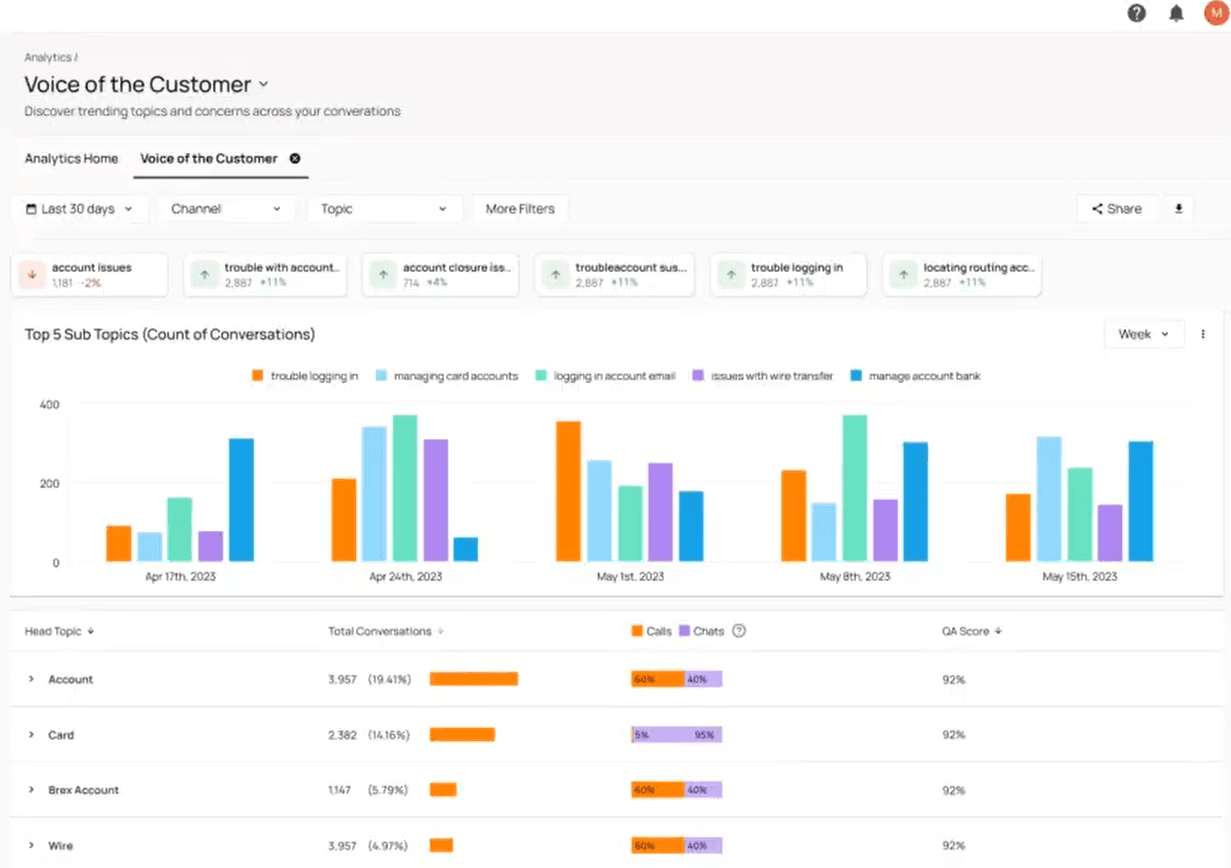
All this gives you a full picture of your customer experience — not just the loudest voices or the ones who happen to fill out your form. You’re no longer limited to a curated list of survey questions. You get raw, honest feedback, directly from your customers, in their own words, at scale.
(Read our latest article on top SurveyMonkey alternatives.)
6. Put the Right Info in Front of Agents, Before They Have to Ask
One of the best ways to boost performance and reduce stress is to put the right information in front of agents as the call unfolds. This keeps agents focused on the customer instead of hunting for answers, switching tabs, or second-guessing policy details.
Start by implementing software that includes real-time transcription, live call monitoring, automatic call summaries, and automatic topic detection. These tools help detect what’s being discussed in the moment, and can trigger smart prompts, suggestions, or pull up knowledge base articles that match the conversation.
Make sure product details, policies, and troubleshooting guides are easy to access and always up to date.
As an example, Level AI’s Real-Time Agent Assist uses natural language understanding and call center voice analytics to comprehend the conversation as it unfolds. This feature instantly pulls up the most relevant information from your knowledge base, so there’s no more frantic tab-switching or putting customers on hold.
Whether it’s an FAQ, a troubleshooting step, a policy detail, or an agent script, it appears right when the agent needs it.

The system also transcribes conversations in real time, helping agents recall what was said earlier, and automatically summarizes what’s been discussed as notes so they can focus on the customer.
It also surfaces resources from other connected systems, like ticketing or internal wikis, so everything’s in one place. As the conversation evolves, so does the guidance: the tool updates in real time to match the flow of the discussion.
Our built-in search assistant AgentGPT suggests search terms for agents in anticipation of what they’ll need to ask next, helping them stay one step ahead. Agents can refine questions, ask for more detail, and get tailored answers instantly.
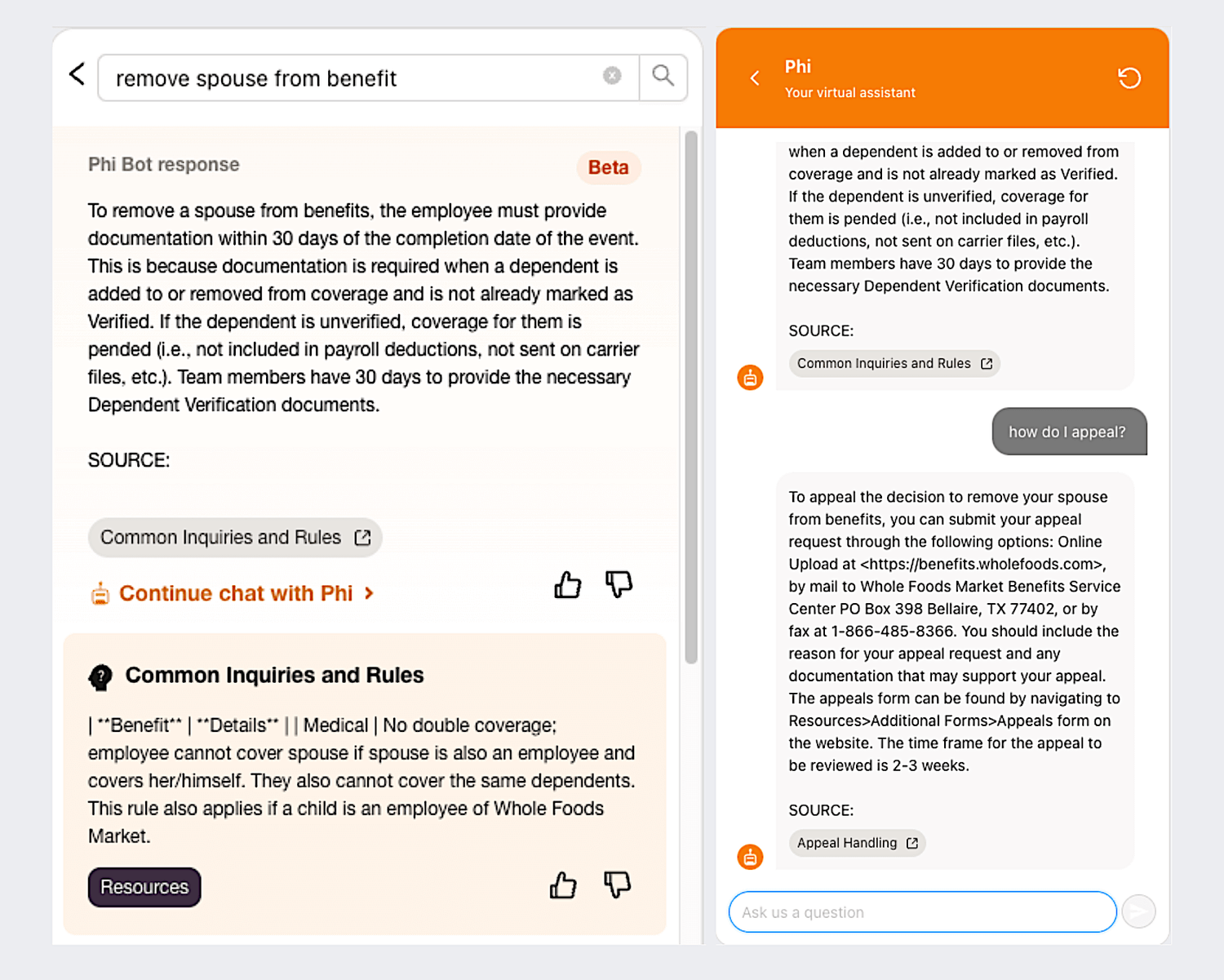
7. Give Managers a Live Window Into Every Conversation
One of the best ways to improve quality and customer satisfaction is to stop problems before they happen, and that starts with giving supervisors real-time visibility into calls in progress.
The best call centers don’t just look at transcripts after the fact — they monitor live interactions in progress. Why? Because catching issues in the moment opens the door to immediate action.
With the right tools, supervisors can monitor live metrics like call duration, hold time, and compliance adherence. They can see when things are going off-track without waiting for the call to end.
When a customer is getting frustrated or an agent seems stuck, call center managers can step in right away. They can offer real-time coaching or support before a bad experience turns into a lost customer. It also allows supervisors to address customer needs on the spot, smooth out escalations, and keep satisfaction high.
An example of this in action is Level AI’s Real-Time Manager Assist, which gives supervisors a live dashboard of every call happening in the contact center, all in one view.
They can see exactly what’s happening in real time, with key insights like agent name, call duration, customer sentiment, and even estimated deal size or upsell probability. You’ll also get the agent’s current InstaScore and automatically flagged coaching opportunities based on what’s happening then and there.
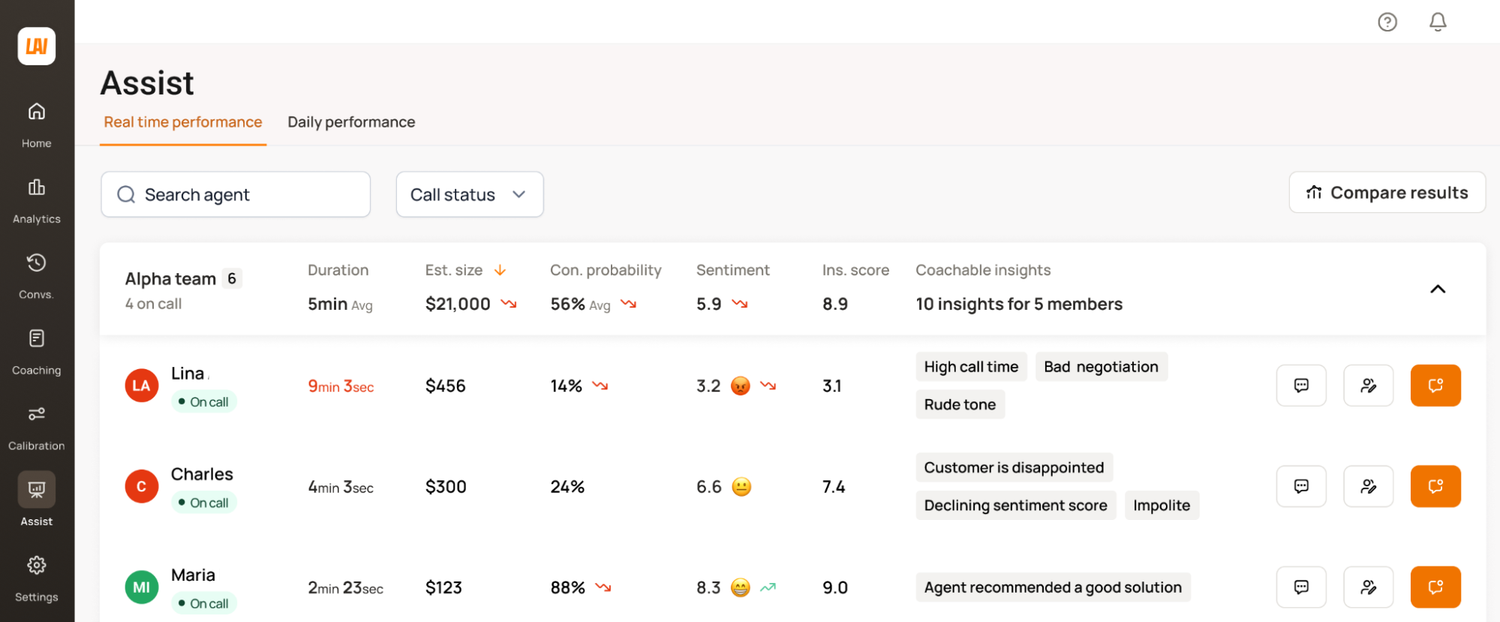
Each data point is clickable, letting managers instantly dig into the “why” behind the numbers. Instead of guessing which calls need attention, they can prioritize their time and jump in when it matters most — whether it’s to help an agent who’s stuck, calm down a frustrated customer, or prevent a deal from slipping away.
This kind of visibility turns call center managers from reactive reviewers into proactive coaches, making it easier to improve call outcomes on the spot and deliver a consistently better customer experience.
8. Use QA Results to Drive Continuous Agent Growth
One of the strongest ways to improve agent performance, boost customer satisfaction, and build a strong team culture is to turn QA results into regular coaching moments.
Start by documenting what’s working and what’s not. Then, use those insights to recommend clear, corrective actions. If you spot common issues in call audits, don’t just note them but act on them. That might mean launching refresher training programs, updating call scripts, or expanding knowledge base content.
We recommend building a continuous feedback loop rather than waiting for quarterly reviews. Use real-time feedback tools and self-coaching features that let agents see how they’re doing right after the interaction. When agents can track their own performance (and understand what good looks like), they’re more likely to improve on their own.
This is where performance dashboards come in. Platforms like Level AI make sharing customer interaction dashboards with agents and managers easy, showing key metrics like call quality scores, call drivers, compliance adherence, and more.

Agents can use dashboards shared with them to track their progress, spot areas for improvement, and take control of their own development without waiting for a manager to step in. It’s a simple way to boost accountability, drive self-coaching, and keep performance moving in the right direction.
9. Don’t Set It & Forget It: QA Needs Regular Checkups
Quality management isn’t a “set it and forget it” system. It’s a living, breathing process that needs periodic attention. Call centers evolve. Customer expectations shift. New tools roll out. If your quality assurance program doesn’t keep up, it quickly loses its edge.
That’s why one of the most important call center quality assurance best practices is to review and refine your QA strategy regularly. This means updating your evaluation criteria, adjusting scorecards, implementing quality monitoring, and checking whether your current metrics still make sense. Ask yourself: are we measuring what really matters?
For example, you might be missing the bigger picture if you’re still prioritizing average handle time (AHT) over resolution quality or customer satisfaction. Today’s customers often expect quick, smooth resolutions, sometimes even through self-service. A low AHT doesn’t mean much if issues go unresolved or customers feel rushed.
It’s the same with call volume. Tracking how many calls an agent handles per shift might sound productive, but it can backfire if it isn’t tied to satisfaction, operational efficiency, or revenue impact. Agents may speed through calls just to hit their numbers, leaving customers frustrated and problems unsolved.
Instead, regularly assess whether your metrics are truly driving value. Compare QA scores with CES, NPS, and other key performance indicators to see if they align. More importantly, don’t forget to ask your team because call center agents and QA evaluators often know where scorecards fall short and where improvements could be made. Their input can help ensure your QA process and workflows reflect real-world challenges, not just checkbox goals.
Finally, think ahead. If your business is growing, is your QA process built to scale? Regular checkups help you spot gaps early, adapt to change, and keep your quality standards strong — no matter how fast things move.
Supercharge Your QA Strategy with Level AI
Level AI replaces guesswork with real data, helping you scale call center quality assurance coverage, reduce average handle time, and improve agent performance — all in one platform.
Interested in implementing an AI-powered quality assurance process in your call center? Book a call with our team to learn how Level AI's secure and customizable Generative AI can transform your contact center's QA process.
Keep reading
View all

